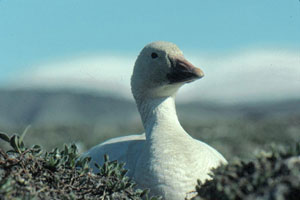
Climate change is strongly affecting Arctic ecosystems, as the distribution and abundance of species is altered and trophic links are disrupted (ACIA 2004). Hence, there is an urgent need to develop programs for conserving biodiversity in response to likely losses of a significant proportion of Arctic species assemblages. This will impact Inuit and other indigenous people that depend on wildlife species.
ArcticWOLVES will launch a circumpolar study of tundra ecosystems aimed at understanding food webs and ecosystem processes that affect them, measuring current impact of climate change on wildlife, and predicting future impacts through monitoring and modelling. Throughout the circumpolar world, terrestrial food webs contain relatively few species and are often dominated by the same groups of species, making them and the systems in which they occur suitable for comparative research.
This initiative aims to build a network of circumpolar wildlife observatories in order to assess the current state of Arctic terrestrial food webs over a large geographical range. Our program has two complementary goals. A first goal is to determine the relative importance of various processes in structuring Arctic food webs and to quantify the magnitude of these interactions. The second goal of ArcticWOLVES is to document direct and indirect impacts of climate change on terrestrial animal biodiversity (insects, mammals, birds), and forecast future impacts on these populations and the Arctic ecosystem in which they occur.
A key component of our project is to simultaneously document changes occurring in a large number of wildlife species at a number of sites over a large geographical range (i.e. the circumpolar world) using standard protocols. These protocols will be standardized across all ArcticWOLVES sites across the circumpolar world to ensure that data are collected in a consistent manner, allowing cross-site comparisons and analyses. These data will be merged in a common database according to the standards set by the IPY data management committee.
This approach will provide the much-needed spatial replicates that are essential to make strong inferences, whereas variability among sites (due to latitude/longitude effects and different rates of climate change) will give insights at different spatial scales and allow a comparative approach. Wildlife species of primary interest for ArcticWOLVES include herbivorous, insectivorous and predatory birds (geese, ptarmigans, shorebirds, gulls, jaegers, and birds of prey), small-mammals and their predators (lemmings, voles, foxes and weasels) and the insect and food plants of these species.
Wildlife research is closely linked to the well-being of northern people. Our project will integrate scientific methodology and traditional knowledge of northern inhabitants to obtain data that will allow us to expand our temporal and spatial resolution of wildlife populations, and to build channels allowing a two-way transfer of knowledge between scientists and northern residents.
The initial phase of ArcticWOLVES will cover the period 2007-2010 but the project is intended to continue after the International Polar Year.
